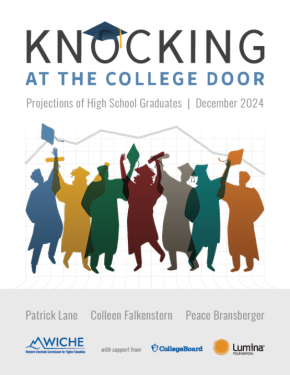Projections of High School Graduate Students
Since 1979, the Western Interstate Commission for Higher Education (WICHE) has published Knocking at the College Door: Projections of High School Graduates. This analysis projects the number of high school graduates for all 50 states and the District of Columbia, making it an important resource for policymakers, decision-makers, researchers, and planners in education and workforce development for years to come. Contact us for more information or to request a presentation.
Key Findings
The total number of high school graduates is expected to peak in 2025 and then decline steadily through 2041.
WICHE projects that the total number of high school graduates will peak in 2025 before entering a period of steady decline through 2041 attributable to fewer births 18 years prior. Ultimately, the nation is projected to see a 13% decline from the peak through the end of the projections.
The number of underrepresented graduates who identify as Hispanic or Multiracial is expected to grow.
These trends — which are based on analysis of public school graduates only — have been evident since WICHE was first able to disaggregate data by race and ethnicity for the 1998 report.
Compared to 2023, 38 states will see declines in the number of graduates by 2041 as most regions in the U.S. will shrink.
The Midwest and Northeast have already experienced declines in the total number of graduates. The South will continue to defy broader national trends with growth followed by a slight decline at the end of the projections, while the West more closely mirrors national projections.
COVID-19’s impact on the education pipeline is modest, but will be felt for years to come.
Graduating classes following the COVID-19 pandemic do not appear to have been substantially impacted in number. However, evidence and data show a decline in enrollments in earlier grades, which produces slightly lower estimates of future graduating classes. Learning loss may be an even bigger and longer-lasting impact of the pandemic.
Beyond the cliff: Potential strategies and solutions to meet the challenges ahead.
Enhancing high school advising, addressing college affordability, developing stronger school-to-work and work-to-learning pathways, and engaging adult learners are just some of the ways states and institutions are meeting the needs of students at every level.

Explore the Data
Choose the format that best suits your needs.
- Download the full report as a PDF.
- Access the raw datasets for a deeper analysis.
- View our interactive data visualizations or build your own chart.



 This work is licensed under a
This work is licensed under a 